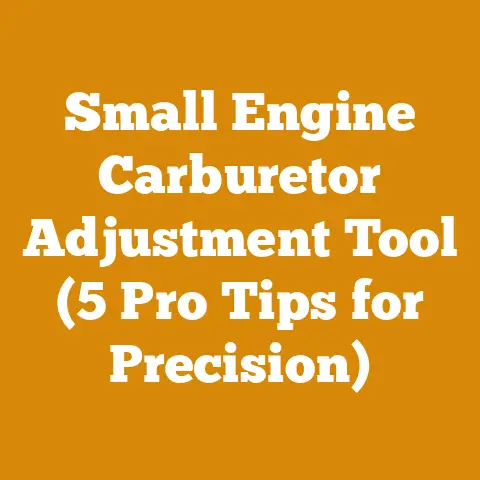Stihl Backpack Blowers (5 Pro Tips for Efficient Wood Cleanup)
Did you know that the average suburban homeowner spends more on leaf removal in a year than a small-scale logger might spend on chainsaw maintenance?
It’s a crazy thought, right?
We often overlook the real costs associated with seemingly simple tasks.
Today, I’m diving deep into how to maximize the efficiency of your wood cleanup using Stihl backpack blowers, and more importantly, how to consider the costs involved.
We’ll look at everything from fuel consumption to long-term maintenance, and how to make informed decisions for your specific needs.
Let’s get started!
But simply owning one isn’t enough.
Maximizing its efficiency – and minimizing your costs – requires a strategic approach.
I’ve spent years working with wood, both professionally and as a hobbyist, and I’ve learned a few tricks to get the most out of these powerful machines.
Tip 1: Mastering the Art of Airflow Control
The first, and perhaps most crucial, tip is mastering airflow control.
It’s not just about blasting everything at full throttle.
That’s a surefire way to waste fuel and potentially damage delicate surfaces.
- Variable Speed Settings: Stihl backpack blowers come with variable speed settings, and understanding how to use them is key.
For light debris like dry leaves, a lower setting is often sufficient.
This conserves fuel and reduces noise.
Think of it like gently persuading the leaves to move, rather than forcing them. - Nozzle Attachments: Experiment with different nozzle attachments.
A flat nozzle provides a wider, more diffused airflow, ideal for clearing large areas of leaves.
A round nozzle delivers a concentrated blast of air, perfect for dislodging stubborn debris or targeting specific areas.
I once used a round nozzle to blow sawdust out of intricate carvings, saving me hours of painstaking brushwork. - Sweeping Technique: Instead of aiming the blower directly at a pile of debris, use a sweeping motion.
This distributes the airflow more evenly and prevents you from simply blowing the debris around in a circle.
Imagine you’re painting with air, moving smoothly and deliberately.
Cost Implication: Using the blower at full throttle constantly significantly increases fuel consumption.
A Stihl BR 800 C-E, at full throttle, consumes approximately 67.6 oz of fuel per hour.
Using lower settings where possible can reduce this consumption by 20-30%, saving you money on fuel costs.
Over a year of regular use, these savings can add up significantly.
Tip 2: Strategic Planning for Optimal Cleanup
Don’t just blindly start blowing.
A little strategic planning can save you time and effort.
- Work with the Wind: Always consider the wind direction.
Blow debris with the wind, not against it.
This reduces the amount of effort required and prevents the debris from simply blowing back into the area you’ve already cleared.
I learned this the hard way after spending an entire afternoon battling a headwind while trying to clear leaves from my driveway. - Create Natural Barriers: Utilize natural barriers like fences, walls, or hedges to contain the debris.
This prevents it from scattering across a wider area.
If no natural barriers exist, consider creating temporary ones using tarps or plywood. - Divide and Conquer: Break down large cleanup tasks into smaller, more manageable sections.
This prevents you from becoming overwhelmed and allows you to focus your efforts more effectively.
Imagine you’re tackling a giant jigsaw puzzle – start with the edges and work your way inwards.
Cost Implication: Strategic planning reduces the overall time spent on cleanup, which translates directly into lower labor costs (if you’re paying someone) and reduced fuel consumption.
Consider this: if you can reduce a 2-hour cleanup task to 1.5 hours through strategic planning, you’ll save roughly 33% on fuel and labor costs.
Tip 3: Maintaining Your Blower for Peak Performance
Regular maintenance is essential for ensuring your Stihl backpack blower operates at peak performance and lasts for years to come.
- Air Filter Cleaning: A dirty air filter restricts airflow, reducing the blower’s power and increasing fuel consumption.
Clean the air filter regularly, ideally after every 10 hours of use.
I recommend having a spare air filter on hand so you can swap it out while the other one is drying after cleaning. - Fuel Filter Replacement: The fuel filter prevents debris from entering the carburetor.
Replace it annually, or more frequently if you’re using low-quality fuel.
Using premium fuel, like Stihl MotoMix, can extend the life of your fuel filter and engine. - Spark Plug Maintenance: A fouled spark plug can cause starting problems and reduce engine performance.
Clean or replace the spark plug annually. - Proper Storage: Store your blower in a dry, sheltered location when not in use.
Drain the fuel tank before storing it for extended periods to prevent fuel degradation.
I learned this lesson the hard way after discovering a gummy, unusable mess in my fuel tank after a long winter.
Cost Implication: Neglecting maintenance can lead to costly repairs down the line.
A clogged carburetor, for example, can cost anywhere from $50 to $150 to repair, depending on the model and the mechanic’s rates.
Regular maintenance, on the other hand, typically costs less than $20 per year in parts and supplies.
Consider it an investment in the long-term health of your blower.
Tip 4: Understanding Fuel and Oil Mix Ratios
Using the correct fuel and oil mix ratio is critical for the longevity of your Stihl backpack blower’s engine.
- Stihl 2-Stroke Oil: Always use high-quality Stihl 2-stroke oil.
This oil is specifically formulated to provide optimal lubrication and protection for Stihl engines. - Correct Ratio: The recommended fuel-to-oil ratio for most Stihl backpack blowers is 50:1 (50 parts gasoline to 1 part oil).
Using the wrong ratio can lead to engine damage.
Too little oil can cause excessive wear, while too much oil can foul the spark plug and reduce engine performance. - Premixed Fuel: Consider using Stihl MotoMix premixed fuel.
This fuel is a convenient and reliable option that eliminates the guesswork of mixing your own fuel.
It also has a longer shelf life than regular gasoline, which is ideal if you don’t use your blower frequently.
Cost Implication: Using the wrong fuel mixture can cause significant engine damage, leading to expensive repairs or even the need for a complete engine replacement.
An engine rebuild can easily cost $300 to $500.
Investing in high-quality 2-stroke oil and using the correct mixing ratio is a small price to pay for protecting your investment.
While MotoMix might seem more expensive upfront, its longer shelf life and consistent quality can actually save you money in the long run by preventing fuel-related problems.
Tip 5: Ergonomics and Safety First
Operating a backpack blower can be physically demanding, so it’s important to prioritize ergonomics and safety.
- Proper Fit: Adjust the shoulder straps and waist belt to ensure a comfortable and secure fit.
A properly fitted blower will distribute the weight evenly and reduce strain on your back and shoulders. - Hearing Protection: Backpack blowers can be loud, so wear hearing protection to prevent hearing damage.
Earplugs or earmuffs are both effective options. - Eye Protection: Wear safety glasses or a face shield to protect your eyes from flying debris.
- Proper Clothing: Wear long pants, a long-sleeved shirt, and sturdy shoes to protect your skin from scratches and cuts.
- Awareness of Surroundings: Be aware of your surroundings and watch out for pedestrians, animals, and obstacles.
Cost Implication: Injuries can be costly, both in terms of medical expenses and lost productivity.
Investing in proper safety gear, such as hearing protection and eye protection, is a relatively inexpensive way to prevent injuries.
Taking breaks to avoid fatigue can also reduce the risk of accidents.
According to the National Safety Council, the average cost of a work-related injury is over $40,000.
Prioritizing safety is not just the right thing to do, it’s also the smart thing to do from a financial perspective.
Deeper Dive into Cost Factors: A Wood Cleanup Budget Breakdown
Now that we’ve covered the pro tips, let’s break down the specific cost factors involved in wood cleanup with a Stihl backpack blower.
This section is designed to help you create a realistic budget for your wood processing or firewood preparation projects.
1. Initial Investment: Purchasing a Stihl Backpack Blower
The first cost you’ll encounter is the initial investment in the blower itself.
Stihl offers a range of backpack blowers, from entry-level models to professional-grade machines.
- Entry-Level Models (e.g., Stihl BR 200): These are suitable for homeowners with small to medium-sized properties.
Expect to pay around $300 – $400. - Mid-Range Models (e.g., Stihl BR 450 C-EF): These offer more power and features, making them suitable for larger properties or light commercial use.
Prices range from $500 to $700. - Professional-Grade Models (e.g., Stihl BR 800 C-E): These are designed for heavy-duty use and offer the highest levels of power and durability.
Expect to pay $700 or more.
Cost Considerations:
- Power Requirements: Consider the size and type of cleanup tasks you’ll be performing.
If you’re primarily clearing leaves from a small yard, an entry-level model may be sufficient.
If you’re clearing heavy debris from a large property, you’ll need a more powerful model. - Features: Look for features that will make your job easier, such as variable speed settings, cruise control, and easy starting.
- Warranty: Check the warranty offered by Stihl.
A longer warranty provides peace of mind and protects your investment.
Example: I recently upgraded from a Stihl BR 200 to a BR 450 C-EF.
The BR 200 was fine for basic leaf cleanup, but it struggled with heavier debris like pine needles and small branches.
The BR 450 C-EF has significantly more power and the easy starting feature is a lifesaver, especially on cold mornings.
The extra $250 was well worth it for the increased performance and convenience.
2. Fuel Costs: The Ongoing Expense
Fuel is a significant ongoing expense associated with operating a Stihl backpack blower.
- Fuel Consumption: Fuel consumption varies depending on the model, engine size, and operating conditions.
Refer to the manufacturer’s specifications for the fuel consumption rate of your specific model.
As mentioned earlier, the Stihl BR 800 C-E consumes approximately 67.6 oz of fuel per hour at full throttle. - Fuel Type: Use high-quality gasoline with an octane rating of 89 or higher.
Avoid using gasoline that contains ethanol, as ethanol can damage the engine. - Fuel Prices: Gasoline prices fluctuate, so factor in these fluctuations when budgeting for fuel costs.
Check local gas prices regularly to get an accurate estimate.
Cost Calculation:
- Hourly Fuel Cost: (Fuel Consumption Rate in oz/hour) / (Ounces per Gallon) * (Price per Gallon)
- Example: (67.6 oz/hour) / (128 oz/gallon) * ($4.00/gallon) = $2.11 per hour
Cost-Saving Tips:
- Use Lower Speed Settings: As mentioned earlier, using lower speed settings whenever possible can significantly reduce fuel consumption.
- Maintain Your Blower: A well-maintained blower will operate more efficiently and consume less fuel.
- Plan Your Work: Strategic planning can reduce the overall time spent on cleanup, which translates directly into lower fuel costs.
Data Point: According to the U.S.
Energy Information Administration (EIA), the average price of gasoline in the United States in 2023 was around $3.50 per gallon.
However, prices can vary significantly depending on location and season.
3. Oil Costs: Protecting Your Engine
As we discussed, using the correct 2-stroke oil and mixing ratio is crucial for protecting your engine.
- Oil Type: Use high-quality Stihl 2-stroke oil.
- Mixing Ratio: The recommended fuel-to-oil ratio for most Stihl backpack blowers is 50:1.
- Oil Prices: Stihl 2-stroke oil typically costs around $10 to $15 per quart.
Cost Calculation:
- Oil Consumption: For a 50:1 mixing ratio, you’ll need 1 ounce of oil for every 50 ounces of gasoline.
- Cost per Gallon of Fuel Mix: (Price per Quart of Oil) / (32 ounces/quart) * (1 ounce of oil needed per 50 ounces of gasoline) * (128 ounces/gallon)
- Example: ($12/quart) / (32 ounces/quart) * (1 ounce/50 ounces) * (128 ounces/gallon) = $0.96 per gallon of fuel mix
Cost Considerations:
- Bulk Purchases: Consider buying oil in bulk to save money.
- Premixed Fuel: As mentioned earlier, Stihl MotoMix premixed fuel eliminates the need to mix your own fuel and ensures the correct oil-to-fuel ratio.
Data Point: A study by the American Petroleum Institute (API) found that using high-quality 2-stroke oil can significantly reduce engine wear and extend the life of small engines.
4. Maintenance Costs: Keeping Your Blower Running Smoothly
Regular maintenance is essential for ensuring your Stihl backpack blower operates at peak performance and lasts for years to come.
- Air Filter: Replace the air filter annually, or more frequently if you’re operating in dusty conditions.
Air filters typically cost around $5 to $10. - Fuel Filter: Replace the fuel filter annually.
Fuel filters typically cost around $5 to $10. - Spark Plug: Clean or replace the spark plug annually.
Spark plugs typically cost around $5 to $10. - Grease: Lubricate the moving parts of the blower regularly.
A tube of grease typically costs around $5 to $10. - Professional Servicing: Consider having your blower professionally serviced every few years.
A professional service typically costs around $50 to $100.
Cost Calculation:
- Annual Maintenance Costs: (Cost of Air Filter) + (Cost of Fuel Filter) + (Cost of Spark Plug) + (Cost of Grease)
- Example: $8 + $8 + $8 + $8 = $32 per year
Cost-Saving Tips:
- Perform Basic Maintenance Yourself: You can save money by performing basic maintenance tasks yourself, such as cleaning the air filter and replacing the spark plug.
- Follow the Manufacturer’s Recommendations: Follow the manufacturer’s recommendations for maintenance intervals and procedures.
Data Point: According to a survey by the Equipment Dealers Association (EDA), the average cost of repairing a small engine is around $100.
Regular maintenance can help prevent costly repairs.
5. Labor Costs: Your Time or Someone Else’s
If you’re paying someone to perform the wood cleanup, labor costs will be a significant factor.
- Hourly Rate: The hourly rate for labor varies depending on location and experience.
Landscaping professionals typically charge between $25 and $50 per hour. - Time Required: The amount of time required for cleanup will depend on the size of the area, the amount of debris, and the efficiency of the worker.
Cost Calculation:
- Total Labor Cost: (Hourly Rate) * (Time Required)
- Example: $35/hour * 4 hours = $140
Cost-Saving Tips:
- Do It Yourself: If you have the time and energy, you can save money by performing the cleanup yourself.
- Negotiate Rates: Negotiate rates with landscaping professionals.
- Get Multiple Quotes: Get multiple quotes from different landscaping professionals to ensure you’re getting a fair price.
Data Point: According to the Bureau of Labor Statistics (BLS), the median hourly wage for landscaping and groundskeeping workers in the United States was $17.42 in May 2022.
However, wages can vary significantly depending on location and experience.
6. Safety Gear Costs: Protecting Yourself
As we discussed earlier, safety gear is essential for protecting yourself from injuries.
- Hearing Protection: Earplugs or earmuffs typically cost around $10 to $20.
- Eye Protection: Safety glasses or a face shield typically cost around $10 to $20.
- Gloves: Work gloves typically cost around $10 to $20.
- Long Pants and Long-Sleeved Shirt: You likely already own these items, but factor in the cost of replacing them if they get damaged during cleanup.
Cost Calculation:
- Total Safety Gear Cost: (Cost of Hearing Protection) + (Cost of Eye Protection) + (Cost of Gloves)
- Example: $15 + $15 + $15 = $45
Cost Considerations:
- Quality: Invest in high-quality safety gear that will provide adequate protection.
- Durability: Choose durable safety gear that will last for years to come.
Data Point: The National Safety Council (NSC) estimates that the average cost of a preventable injury is over $40,000.
Investing in safety gear is a small price to pay for preventing injuries.
Case Studies: Real-World Cost Scenarios
Let’s look at a couple of real-world case studies to illustrate how these cost factors can play out in different scenarios.
Case Study 1: Homeowner Clearing Leaves from a Small Yard
- Scenario: A homeowner needs to clear leaves from a small yard (approximately 0.25 acres).
They own a Stihl BR 200 backpack blower. - Cost Breakdown:
- Initial Investment (Stihl BR 200): $350 (already owned)
- Fuel Costs: $5 per hour * 2 hours = $10
- Oil Costs: $1 per gallon of fuel mix * 2 gallons = $2
- Maintenance Costs: $32 per year / 12 months = $2.67 per month (allocated cost)
- Labor Costs: $0 (doing it themselves)
- Safety Gear Costs: $0 (already owned)
- Total Cost: $10 + $2 + $2.67 = $14.67
Case Study 2: Landscaping Company Clearing Debris from a Large Property
- Scenario: A landscaping company needs to clear debris from a large property (approximately 1 acre).
They use a Stihl BR 800 C-E backpack blower. - Cost Breakdown:
- Initial Investment (Stihl BR 800 C-E): $800 (already owned)
- Fuel Costs: $2.11 per hour * 8 hours = $16.88
- Oil Costs: $0.96 per gallon of fuel mix * 8 gallons = $7.68
- Maintenance Costs: $32 per year / 12 months = $2.67 per month (allocated cost)
- Labor Costs: $35 per hour * 8 hours = $280
- Safety Gear Costs: $45 (new gloves and earplugs)
- Total Cost: $16.88 + $7.68 + $2.67 + $280 + $45 = $352.23
These case studies illustrate how the different cost factors can vary depending on the specific scenario.
Optimizing Your Budget: Practical Tips for Cost Management
Here are some practical tips for optimizing your budget and minimizing your costs when using a Stihl backpack blower for wood cleanup:
- Choose the Right Blower: Select a blower that is appropriately sized for your needs.
Don’t overspend on a model that is too powerful for your typical cleanup tasks. - Maintain Your Blower Regularly: Regular maintenance will help your blower operate more efficiently and last longer, reducing the need for costly repairs.
- Use High-Quality Fuel and Oil: Using high-quality fuel and oil will protect your engine and prevent fuel-related problems.
- Plan Your Work Strategically: Strategic planning can reduce the overall time spent on cleanup, which translates directly into lower fuel and labor costs.
- Do It Yourself When Possible: If you have the time and energy, you can save money by performing the cleanup yourself.
- Negotiate Rates with Landscaping Professionals: If you’re hiring someone to perform the cleanup, negotiate rates and get multiple quotes.
- Buy Supplies in Bulk: Consider buying fuel, oil, and maintenance supplies in bulk to save money.
- Take Advantage of Sales and Discounts: Keep an eye out for sales and discounts on Stihl products and supplies.
- Consider Renting: If you only need a backpack blower occasionally, consider renting one instead of buying one.
Rental fees typically range from $50 to $100 per day.
The Final Sweep: Actionable Takeaways
By now, you should have a clear understanding of the costs involved in using a Stihl backpack blower for wood cleanup and how to manage your budget effectively.
Here are some actionable takeaways:
- Assess Your Needs: Before purchasing a blower, assess your needs and choose a model that is appropriately sized for your typical cleanup tasks.
- Create a Budget: Create a detailed budget that includes all of the relevant cost factors, such as fuel, oil, maintenance, labor, and safety gear.
- Track Your Expenses: Track your expenses to ensure you’re staying within your budget.
- Implement Cost-Saving Strategies: Implement the cost-saving strategies outlined in this article to minimize your costs.
- Prioritize Safety: Always prioritize safety when operating a backpack blower.
Remember, wood cleanup doesn’t have to break the bank.
With careful planning, strategic execution, and a commitment to regular maintenance, you can keep your costs under control and enjoy the benefits of a clean and well-maintained property.
As the old saying goes, “a penny saved is a penny earned,” and in the world of wood processing, every little bit counts!
Now, go forth and conquer that wood cleanup, armed with knowledge and a well-managed budget!






